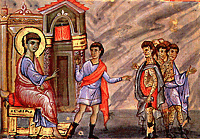 |
|
 |
Economic destitution - Epidemics
 he destitution that chiefly afflicted the rural population of the state
he destitution that chiefly afflicted the rural population of the state
 constituted an important factor in all the demographic developments of the late Byzantine period. The poorer households were those that appear as a non-stable element. The richer the household, the greater its chance of remaining in its original home and the greater the possibility not only that at least one of its members would survive, but also that he or she would set up a new home in the family's place of origin. Extreme poverty was also a factor that contributed to the gradual decline in the population, not only because it resulted in increasing mortality, but also because of the fall in the birth rate. At the same time, the unfavourable economic conditions led the rural poor to abandon the landowners they worked for and migrate, in their search for safer living conditions on the estate of another landowner or in a fortified city. constituted an important factor in all the demographic developments of the late Byzantine period. The poorer households were those that appear as a non-stable element. The richer the household, the greater its chance of remaining in its original home and the greater the possibility not only that at least one of its members would survive, but also that he or she would set up a new home in the family's place of origin. Extreme poverty was also a factor that contributed to the gradual decline in the population, not only because it resulted in increasing mortality, but also because of the fall in the birth rate. At the same time, the unfavourable economic conditions led the rural poor to abandon the landowners they worked for and migrate, in their search for safer living conditions on the estate of another landowner or in a fortified city.
External destructive factors, such as epidemics,
added to the misery described in historical sources. The great epidemic of
the plague, which broke out in 1347, contributed to a great extent to the
decline of population apparent in the late Byzantine period. The plague
spread rapidly, striking chiefly at the cities and villages and taking a
heavy toll of lives. It is beyond doubt that those more often hit by the
plague were the poor. Because our information on this epidemic is
scant, we need to refer to existing evidence regarding the plague
that broke out at the same time in Western Europe. Even though this
assumed far greater dimensions there than in Byzantium, the fact that it
resulted in the disappearance of a large part of the population is proof
enough of the catastrophic consequences of an epidemic of this kind.
|